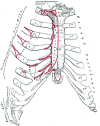Ultrasonography of sternal fractures
- PMID: 28191123
- PMCID: PMC5024903
- DOI: 10.1002/j.2205-0140.2011.tb00131.x
Ultrasonography of sternal fractures
Abstract
This paper describes the use of clinician-performed ultrasound to detect sternal fractures in trauma patients. It is a pictorial essay that describes the ultrasound technique, the normal anatomy and ultrasound findings, variants, potential pitfalls and the appearance of fractures when they occur in both children and adults.
Keywords: sternal fracture; sternum; ultrasonography; ultrasound.
Figures










References
-
- Rose JS. Ultrasound in abdominal trauma. Emerg Med Clin North Am 2004; 22(3): 581–99, vii. - PubMed
-
- McGahan JP, Richards J, Fogata ML. Emergency ultrasound in trauma patients. Radiol Clin North Am 2004; 42 (2): 417–25. - PubMed
-
- Brookes JG, Dunn RJ, Rogers IR. Sternal fractures: a retrospective analysis of 272 cases. J Trauma 1993; 35 (1): 46–54. - PubMed
-
- Recinos G, Inaba K, Dubose J, Barmparas G, Teixeira PG, Talving P, et al. Epidemiology of sternal fractures. Am Surg 2009; 75 (5): 401–4. - PubMed
-
- Mazzocca AD, Garretson R, Romeo AA. Section I: Sternum and Rib Fractures in Adults and Children. In: DeLee JC, Drez D, Miller MD, editors. DeLee and Drez's Orthopaedic Sports Medicine. 2nd ed. Philadelphia: Elsevier Science; 2003.
LinkOut - more resources
Full Text Sources
